If you want to land the best jobs, you need to accompany your CV with a strong cover letter.
In this guide, I will show you how to write a cover letter that will get you noticed by employers and ensure you land plenty of interviews.
Starting with a basic overview…
To write an effective cover letter you must:
- Apply a professional format and layout
- Address the recipient by name
- Explain why you are suitable for the job you are applying for
- Explain why you are applying for the job
- Encourage the recruiter to open your CV
What is a cover letter?
Before you delve into this guide, it’s important to understand what a cover letter is, and what it’s purpose is.
Having a good understanding of these 2 factors will help you to create a really effective cover letter.
A cover letter is simply an introductory note which you send to recruiters and employers, when sending your CV
Here’s an example of a typical cover letter
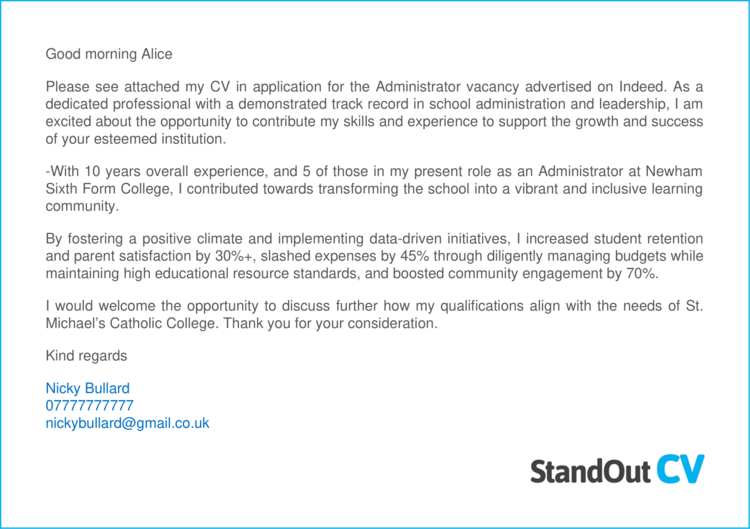
What’s the purpose of a cover letter?
The purpose of your cover letter is to do the following 3 things;
- Introduce yourself
- Build rapport with the recruiter or employer
- Encourage them to open your CV
Cover letter format
Before you start to write your cover letter, you need to understand the basics of formatting one, and the structure to follow.
Using the correct format will ensure that your cover letter is easy for busy recruiters to read, and that you can highlight the important information that they want to see.
Use the following tips to format and layout your CV for best results.
Write your cover letter in the body of your message or email
The number one cover letter formatting rule to remember is, write your cover letter in the body of your email (or messaging box if you are sending via a job website).

Never attach your cover letter as a separate document.
You want your cover letter to be instantly visible to recruiters and employers, form the moment they open your application.
If you attach it separately, you simply slowing down the process, and run the risk of having your application ignored (especially if it takes a long time for the document to open).
So, always write your cover letter in the body of your application message if you want to make an instant connection with the recipient.
Quick tip: If you are writing your cover letter in an email, use an eye-catching subject line that tailors your skills to the jobs. E.g. Developer with 5 years web app experience


Cover letter layout
Every cover letter will be different of course, but try to stick to this basic layout as much as possible, in order to provide the right information, in a logical order.
This will help you to build rapport with readers, and sell yourself to them in the short window of their attention you have.
Start by addressing the recipient
The first thing you need to do in your cover letter, is address the person you are approaching.

Follow with a friendly greeting
You want to appear professional when applying for jobs, but you also need to be friendly and personable.
So, follow with a friendly greeting such as;
- Hope you’re well
- I hope this email finds you well
Always remember that your message will be read by a real person, and they will appreciate being treated well.
Explain which job you are applying for
Once you’ve greeted and warmed up the recruiter with a friendly opening, it’s time to get to the point.
Let the recruiter know exactly which job you are applying for.

Remember that some recruiters will be working scores of vacancies, so be as specific as you can.
Explain why you are suitable for the job
In the body of your cover letter, you should provide a brief explanation of what makes you suitable for the job you are applying for.
This is ultimately what will encourage a recruiter or hiring manager to open your CV.

I will cover how to do this in more detail in the “What to include in a cover letter” section of the guide.
Sign off in a friendly and professional manner
Remembering that your cover letter is a means of communication with the person receiving it – sign off in a friendly yet professional way.
Use a term like;
- Regards
- Kind regards
- Look forward to hearing from you
Finish with a professional signature
Finally, at the very bottom of your cover letter, add a professional signature.
This will ensure it looks professional, and provide the reader with instant access to your contact details.

Quick tip: If you are writing a cover letter in email, format your signature to make it look extra-professional, and save it as your default signature for all of your outgoing mails.


How to start a cover letter
To start a cover letter, you should always aim to address the recipient by name – this is the best way to start building rapport.

But you are probably thinking, “How do I find their name??”
There are a few ways you can find the name of the person handling the vacancy
- On the job advert – sometimes the name and email address will be on the job advert itself
- Company website – If you’re applying directly to a company, you can often find the recruitment team or head of department on the company About us section
- LinkedIn – If you can determine the company and team for the vacancy, a search on LinkedIn can often uncover the most likely person to be handling the applications.
“What if I can’t find a name?”
If you can’t find a name, don’t panic – you won’t always be able to.
Simply address the recruiter with the word “Hi” – that’s all you can do in that instance.
Don’t use the phrase “Dear sir or madam” – It’s very old-fashioned and impersonal.
How long should a cover letter be?
A cover letter should be short and sweet.
The purpose of a cover letter, is simply to persuade recruiters to open your CV, so it doesn’t need to be long.
You only need 3 – 6 sentences to write a good cover letter.
You have to bear in mind that recruiters and hiring managers are busy people, so you need to move them on to opening your CV quickly – or you might lose their attention.
What to include in a cover letter
The content you include in your cover letter will determine whether or not the recruiter is impressed by you, and if they will go on to open your CV.
So, it’s crucial that you include the information they want to see.
Here’s what to include…
Firstly, read the job advert properly
Before you start writing your cover letter, you must ensure that you understand what the recruiter wants from applicants.
Study the job advert carefully, and pick out the most important candidate requirements.
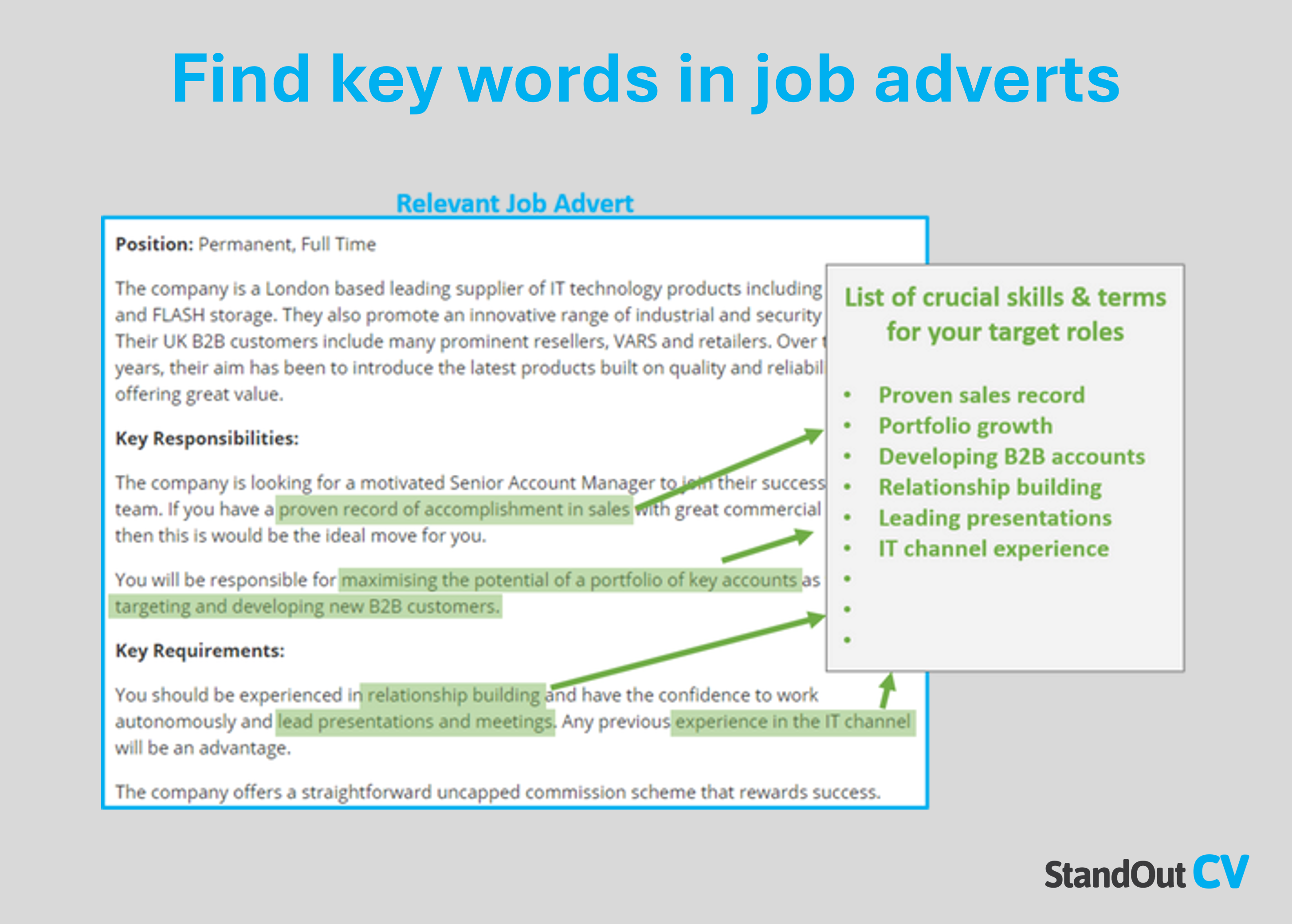
Focus mainly on hard skills such as languages, IT systems, industry experience etc.
Don’t focus on personal skills (such as adaptability, teamwork etc,) as they are needed for most jobs and won’t make you stand out.
Once you know what the recruiter wants from a successful candidate, try to reflect those attributes when writing the below points.
Industry skills
If you’re an experienced candidate, employers will mainly be interested in the work you have done in your industry, tools you are familiar with, type of projects you have worked on etc. so make these a focal point of your cover letter.
If you are less experienced (like a graduate or school leaver) focus on adding transferable skills from your studies, that can be carried over to the workplace.
Length of experience
Recruiters will need to know how much experience you have.
- Are you a graduate?
- Junior?
- Senior with 15 years of experience?
Qualifications
If the role you are applying for requires certain qualifications, then it’s crucial to mention them in your cover letter.
However, if the job advert doesn’t ask for them, or you simply know qualifications aren’t important to perform the role – then you can leave them out.
What you are currently doing
Recruiters will want to know what your current situation is, so be sure to inform them.
- Are you currently working in a similar role?
- Have you just left school?
- Are you immediately available, or do you have to work notice?
Your motivation for applying
One question that recruiters will often ask when they receive an application is, “why is this person applying for the role?”
And you need to answer that question in your cover letter.
Your reasons for applying should be positive, and suggest that you are looking to make a firm commitment to the employer.
Do write: “After spending 2 years as senior manager at my current firm, I am looking to take a step up to manage a bigger team in a more specialist market”
Don’t write: “I’ve recently been fired from my old job, so I need a new one quickly”
Results you’ve achieved for employers
If you’re an experienced candidate, it’s a good idea to allude to the kind of results you have achieved for your current or previous employers.
Maybe you have;
- Saved them money
- Brought on new customers
- Improved processes
- Made plenty of sales
Only give an overview in your cover letter to keep things brief – save the detail for your CV.


How to end a cover letter
To end a cover letter, you should do 2 things; provide a strong call-to-action, and sign of professionally.
Provide a strong call to action
What is a call to action?
It’s simply a request to the reader to take a specific action…
In the case of your cover letter, the action you want the recruiter to take is open your CV.
So it can be helpful to write a line like,
“Please find my CV attached” near the bottom of your cover letter, to encourage readers to do so.
Sign off professionally
Finish your cover letter with a friendly term such as, “kind regards” followed by your name.
Then add a professional signature to the bottom, like the one below;

This makes the cover letter look professional and ensures that recruiters have;
- Your full name
- Phone number
- Email address
Cover letter samples
To give you some ideas and inspiration for writing your cover letter, here are 6 example cover letters.
Customer service cover letter

This customer service cover letter is short and to-the-point – it quickly delivers a host of reasons why this candidate would be valuable in a customer service role.
Finance cover letter
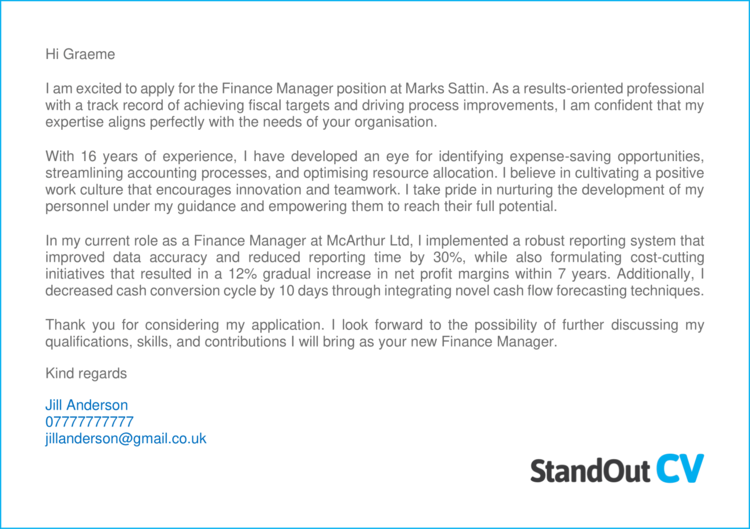
This cover letter outlines the candidate’s finance knowledge, and how they could apply it in the workplace
Graduate cover letter
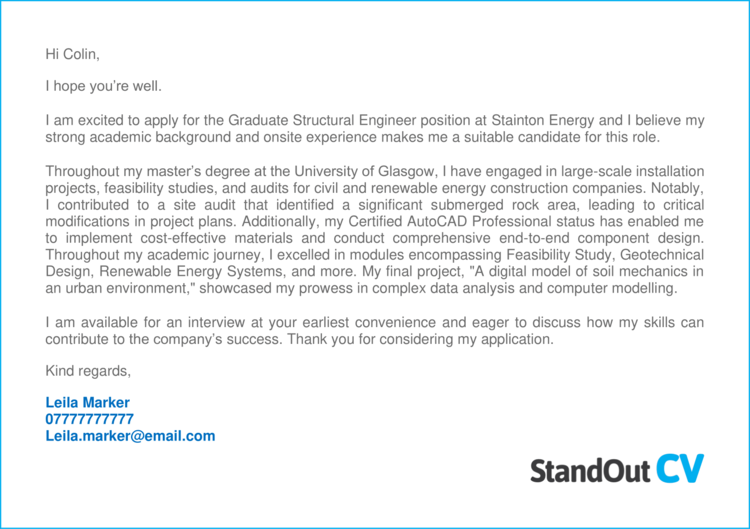
Graduate’s cover letters are a little longer than most, as they don’t have as much experience, so need to describe their education and transferable skills.
Sales cover letter
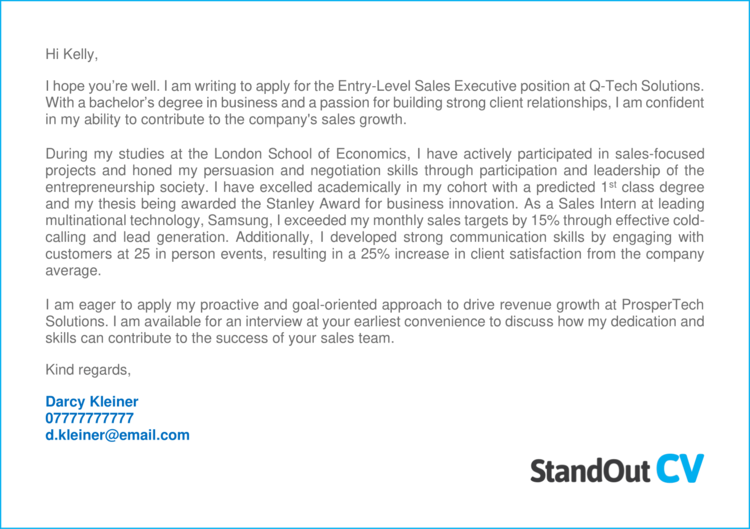
This cover letter boasts the candidate’s ability to make sales and drive revenue.


Project management cover letter
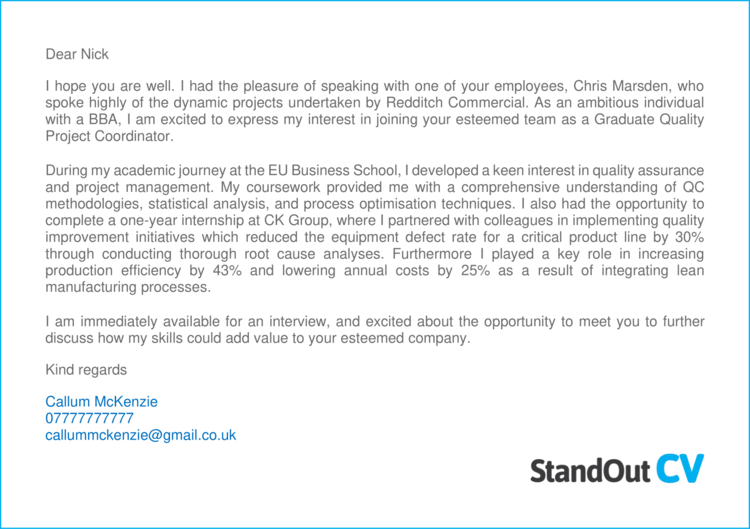
Teacher cover letter
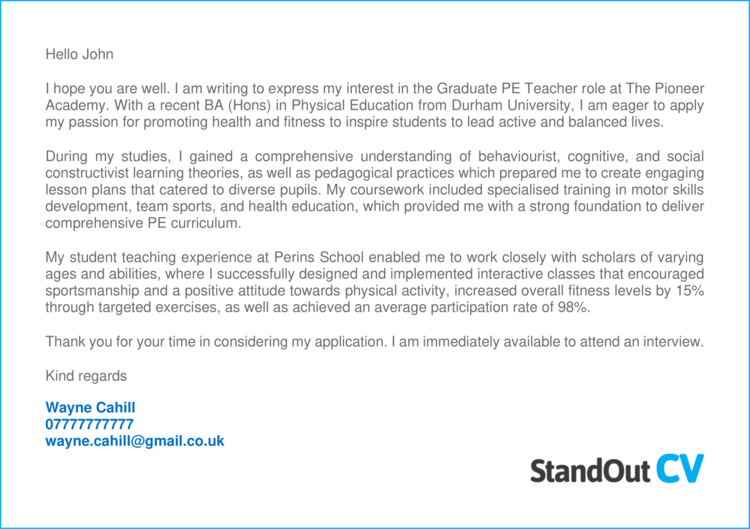
Cover letter mistakes
When writing your cover letter, be sure to avoid some of these common mistakes…
Don’t attach your cover letter as a separate document
You want the contents of your cover letter to instantly greet and connect with the recruiter opening it – so attaching it as separate document will slow that process down.
It doesn’t make sense to attach it as a separate document when you can write in the body of your email or message.
Don’t write a whole side of A4
Your cover letter should be a brief introduction and overview of your suitability for the job.
If you write too much, you risk boring the reader and they might skip past your application.
Save the in-depth details for your CV.
Don’t copy and paste the same cover letter
When your applying for lots of jobs, it can be tempting to simply copy and paste your cover letter into every application.
Whilst this will save you time, it will have a negative effect on your applications.
If you don’t take the time to tailor your cover letter for every job, it’s likely that you will miss some of the key requirements for each job, and therefore you will not make as good as impression as you could have.
It’s OK to work from a template, to keep the structure and some important points that you might repeat for most applications – but always tailor each cover letter to the job spec, for best results.
Don’t use “Dear sir or Madam”
This greeting many have worked well in the 1800’s, but it’s dated and impersonal now.
A simple “Hi” is a friendly and professional way to start your cover letter nowadays.
How to write a cover letter – conclusion
Your cover letter is a crucial tool in the quest to land interviews in the job market.
If you follow the advice above, you should be able to create a concise and powerful cover letter that will excite recruiters, and take you one step closer to landing that dream job
Good luck with your job search!

